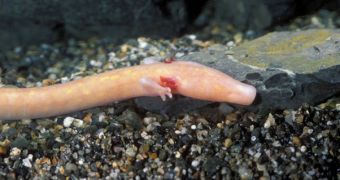The secret to preventing aging may lie in the limestone caves of southern Europe, a group of scientists believes. At this location, they found the olm, or proteus (Proteus anguinus), a species of salamanders that really stands out from the crowd. These blind creatures, which were once considered to be baby dragons due to their shape, have an average life expectancy of no less than 69 ears, with the most long-lived individuals thought to be capable of reaching as much as 100 years old.
In addition to living as much as three times longer than related species, these animals are also very peculiar because they do not exhibit factors that one would expect to find in a long-lived species. The creatures do not posses excessively high levels of antioxidants in their bodies, or even very slow metabolism, like in other animals that live for prolonged periods of time. It is for this reason that experts believe the creatures may hold the key to developing new methods of stopping our own species from getting older at its current pace.
Two of the things that stand our in the olm are its lack of functioning eyes, and the total absence of any skin pigment. The animal lives largely underground, which means that it never experiences daylight. This means that it has no need to produce protectice skin pigments. Eyes are also useless, and so the blind salamander has evolved to exhibit atrophied visual organs. But the question that intrigues science most is what mechanisms these animals employ in order to stay alive for so long. Everything from their habitat to their size (25 to 30 centimeters in length) hints that they should have a short life span.
But experts at the Universite Claude Bernard Lyon, in France, led by ecophysiologist Yann Voituron, believe they may have found an answer to this question. They conducted a series of studies on the Moulis station, the only place in the world were olms are successfully bred in captivity. “We knew for a long time that it had a long life span, but we never had enough data to check it for sure,” the team leader says. He explains that the blind salamander reaches mating age at around 15.6 years, and that it deposits about 36 eggs once ever dozen years or so.
“Although the olm does not have a remarkably low metabolic rate, it is extremely inactive during its life. It has no predators in the caves, so it's not stressed. It just needs to move sometimes to feed and reproduce one time per 12 years,” Voituron tells LiveScience. His work is detailed in the July 21 online issue of the esteemed scientific journal Biology Letters.

 14 DAY TRIAL //
14 DAY TRIAL //